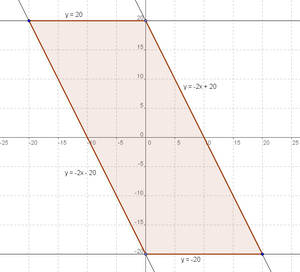Difference between revisions of "1998 AIME Problems/Problem 3"
Realquarterb (talk | contribs) (→Solution) |
|||
| (5 intermediate revisions by 4 users not shown) | |||
| Line 1: | Line 1: | ||
== Problem == | == Problem == | ||
| + | The graph of <math> y^2 + 2xy + 40|x|= 400</math> partitions the plane into several regions. What is the area of the bounded region? | ||
== Solution == | == Solution == | ||
| + | The equation given can be rewritten as: | ||
| + | |||
| + | :<math>40|x| = - y^2 - 2xy + 400</math> | ||
| + | |||
| + | We can split the equation into a piecewise equation by breaking up the [[absolute value]]: | ||
| + | |||
| + | :<math>40x = -y^2 - 2xy + 400\quad\quad x\ge 0 </math> | ||
| + | :<math>40x = y^2 + 2xy - 400 \quad \quad x < 0</math> | ||
| + | |||
| + | Factoring the first one: (alternatively, it is also possible to [[completing the square|complete the square]]) | ||
| + | |||
| + | :<math>40x + 2xy = -y^2 + 400</math> | ||
| + | :<math> 2x(20 + y)= (20 - y)(20 + y)</math> | ||
| + | |||
| + | [[Image:AIME_1998-3.png|right|thumb|300px]] | ||
| + | |||
| + | Hence, either <math>y = -20</math>, or <math>2x = 20 - y \Longrightarrow y = -2x + 20</math>. | ||
| + | |||
| + | Similarily, for the second one, we get <math>y = 20</math> or <math> y = -2x - 20</math>. If we graph these four equations, we see that we get a parallelogram with base 20 and height 40. Hence the answer is <math>\boxed{800}</math>. | ||
| + | |||
| + | == Solution 2 == | ||
| + | The equation can be rewritten as: <math>(x+y)^2=(|x|-20)^2</math>. Do casework as above. | ||
== See also == | == See also == | ||
| − | + | {{AIME box|year=1998|num-b=2|num-a=4}} | |
| + | |||
| + | [[Category:Intermediate Algebra Problems]] | ||
| + | [[Category:Intermediate Geometry Problems]] | ||
| + | {{MAA Notice}} | ||
Latest revision as of 19:13, 23 February 2018
Contents
Problem
The graph of ![]() partitions the plane into several regions. What is the area of the bounded region?
partitions the plane into several regions. What is the area of the bounded region?
Solution
The equation given can be rewritten as:
We can split the equation into a piecewise equation by breaking up the absolute value:
Factoring the first one: (alternatively, it is also possible to complete the square)
Hence, either ![]() , or
, or ![]() .
.
Similarily, for the second one, we get ![]() or
or ![]() . If we graph these four equations, we see that we get a parallelogram with base 20 and height 40. Hence the answer is
. If we graph these four equations, we see that we get a parallelogram with base 20 and height 40. Hence the answer is ![]() .
.
Solution 2
The equation can be rewritten as: ![]() . Do casework as above.
. Do casework as above.
See also
| 1998 AIME (Problems • Answer Key • Resources) | ||
| Preceded by Problem 2 |
Followed by Problem 4 | |
| 1 • 2 • 3 • 4 • 5 • 6 • 7 • 8 • 9 • 10 • 11 • 12 • 13 • 14 • 15 | ||
| All AIME Problems and Solutions | ||
The problems on this page are copyrighted by the Mathematical Association of America's American Mathematics Competitions. 










